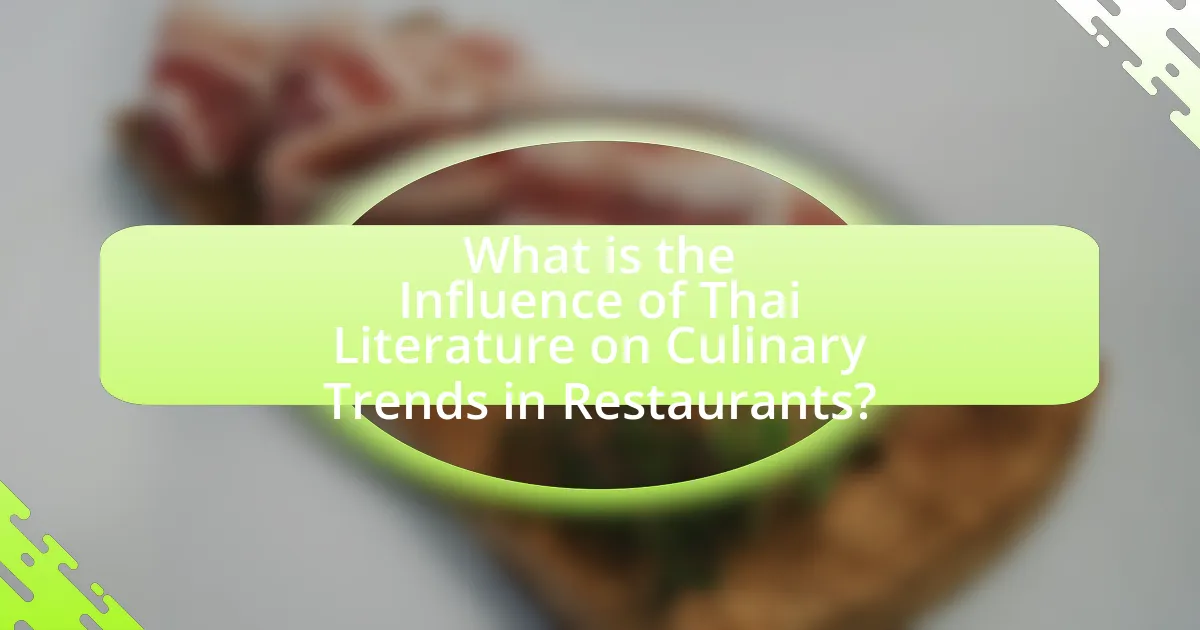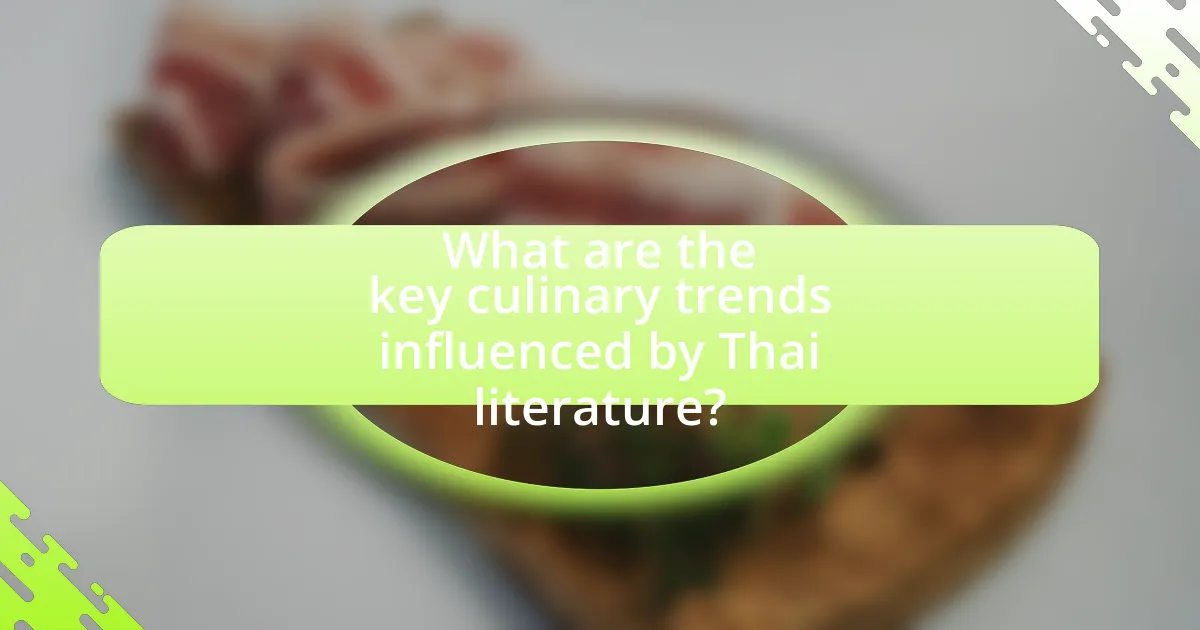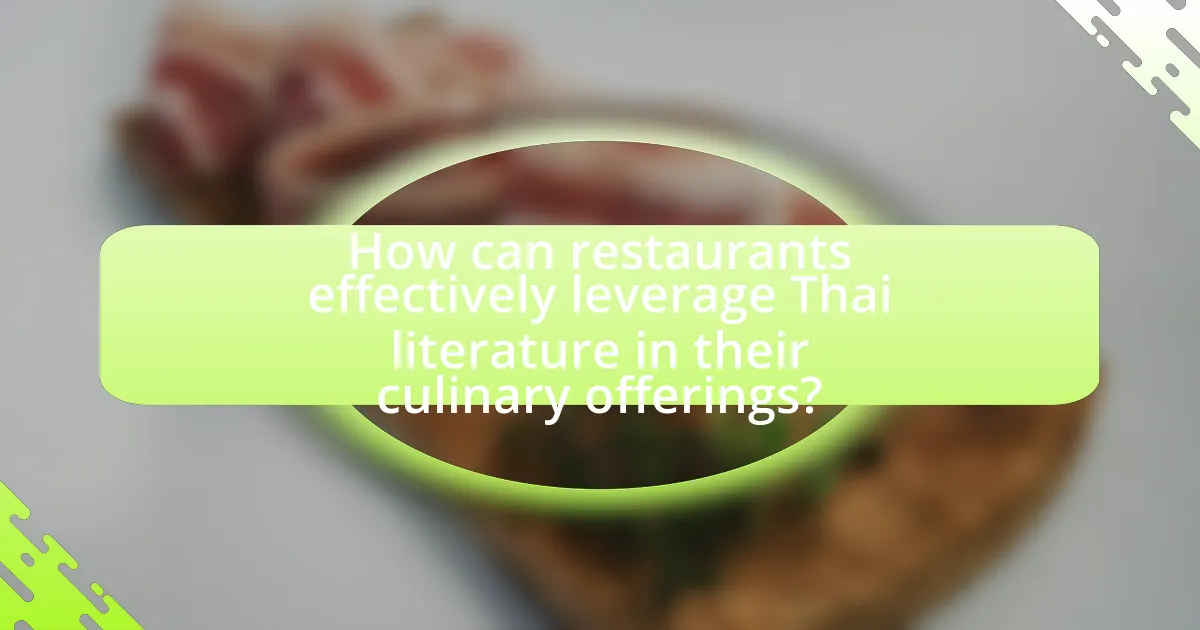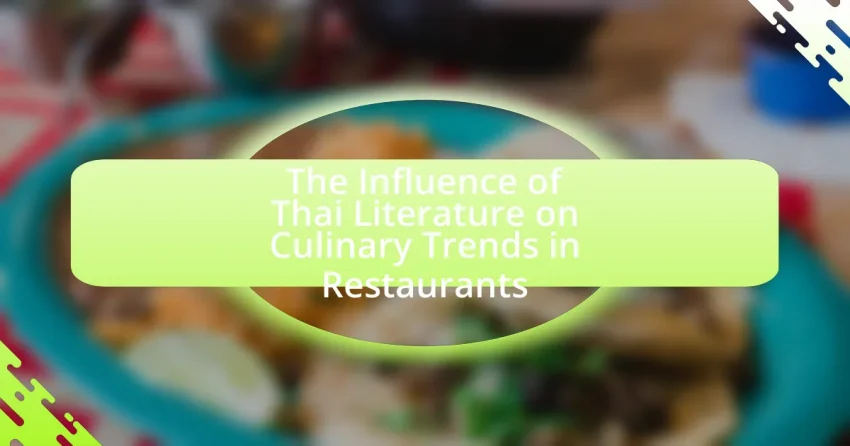The article examines the significant influence of Thai literature on culinary trends in restaurants, highlighting how traditional narratives and cultural elements inspire chefs to create dishes that reflect Thailand’s rich heritage. It discusses the role of classic texts in shaping culinary practices, emphasizing communal dining, seasonal ingredients, and the importance of local produce. Key themes from Thai literature, such as the interplay between nature and cuisine, are explored, along with how these narratives enhance the dining experience and shape perceptions of Thai cuisine. The article also outlines successful examples of restaurants that effectively integrate literary references into their menus and ambiance, showcasing the ongoing dialogue between literature and culinary arts.

What is the Influence of Thai Literature on Culinary Trends in Restaurants?
Thai literature significantly influences culinary trends in restaurants by inspiring chefs to incorporate traditional narratives and cultural elements into their dishes. This influence manifests through the use of ingredients and cooking techniques described in classic Thai texts, such as “The Four Reigns” by Kukrit Pramoj, which highlights the importance of seasonal ingredients and regional flavors. Additionally, contemporary chefs often draw from literary themes to create menus that tell a story, enhancing the dining experience and connecting patrons to Thai heritage. The integration of literary references not only enriches the culinary landscape but also promotes a deeper appreciation for Thai culture among diners.
How does Thai literature reflect cultural values in culinary practices?
Thai literature reflects cultural values in culinary practices by emphasizing the importance of communal dining, the use of fresh ingredients, and the celebration of seasonal flavors. This is evident in traditional Thai texts that highlight the role of food in fostering social bonds and family connections, illustrating how meals are often shared among family and friends. Additionally, literary works often describe the meticulous preparation of dishes, showcasing the cultural reverence for culinary craftsmanship and the significance of local produce, which aligns with Thailand’s agricultural heritage. For instance, the classic Thai poem “Phra Aphai Mani” includes vivid descriptions of food that underscore the connection between nature and culinary art, reinforcing the cultural value placed on harmony with the environment and the joy of sharing meals.
What themes in Thai literature are prevalent in culinary contexts?
Prevalent themes in Thai literature within culinary contexts include the celebration of food as a cultural identity, the interplay between nature and cuisine, and the moral lessons conveyed through culinary experiences. Thai literature often emphasizes food as a reflection of social status and community, showcasing dishes that symbolize regional diversity and familial bonds. Additionally, nature’s influence on culinary practices is highlighted, with descriptions of seasonal ingredients and traditional cooking methods that respect the environment. Moral lessons are frequently embedded in culinary narratives, illustrating the importance of sharing meals and the values of hospitality. These themes collectively underscore the integral role of food in Thai cultural expression and social cohesion.
How do literary narratives shape perceptions of Thai cuisine?
Literary narratives significantly shape perceptions of Thai cuisine by embedding cultural values and culinary traditions within storytelling. These narratives often highlight the sensory experiences associated with food, such as flavors, aromas, and textures, which influence readers’ understanding and appreciation of Thai dishes. For instance, works like “The Spirit of Thai Cuisine” by Vatcharin Bhumichitr illustrate the importance of ingredients and cooking methods, thereby enhancing the reader’s perception of authenticity and richness in Thai culinary practices. Additionally, literary descriptions of communal dining experiences foster a sense of connection and cultural identity, further shaping how Thai cuisine is perceived both locally and globally.
Why is Thai literature significant in the evolution of culinary trends?
Thai literature is significant in the evolution of culinary trends because it encapsulates cultural narratives and traditional recipes that have shaped Thai cuisine. Historical texts, such as “The Royal Chronicles of Ayutthaya,” document the culinary practices and ingredients used in royal courts, influencing modern interpretations of Thai dishes. Additionally, literary works often reflect the importance of food in social and religious contexts, promoting the use of local ingredients and traditional cooking methods that continue to inspire contemporary chefs. This literary heritage not only preserves culinary knowledge but also fosters a deeper appreciation for the cultural significance of food in Thailand, thereby impacting culinary trends in restaurants.
What historical connections exist between Thai literature and food culture?
Thai literature and food culture are historically interconnected through the depiction of culinary practices and the celebration of food in literary works. Classic Thai texts, such as “Phra Aphai Mani” by Sunthorn Phu, illustrate the importance of food in social and cultural contexts, often highlighting specific dishes and their significance in Thai society. Additionally, traditional poetry and folk tales frequently reference food as a symbol of hospitality and community, reinforcing its role in cultural identity. This literary emphasis on food has influenced contemporary culinary trends, as restaurants often draw inspiration from these literary references to create authentic dining experiences that reflect Thailand’s rich cultural heritage.
How has Thai literature inspired modern culinary innovations?
Thai literature has inspired modern culinary innovations by providing rich narratives and cultural contexts that influence contemporary chefs’ creativity and ingredient selection. The vivid descriptions of food in classic Thai texts, such as “Phra Aphai Mani,” highlight traditional cooking methods and regional flavors, which chefs reinterpret in innovative ways. For instance, the emphasis on balance in flavors—sweet, sour, salty, and spicy—found in Thai poetry encourages chefs to experiment with fusion dishes that maintain these core principles while incorporating global ingredients. This literary influence is evident in restaurants that blend traditional Thai recipes with modern techniques, showcasing the ongoing dialogue between literature and culinary arts.

What are the key culinary trends influenced by Thai literature?
Key culinary trends influenced by Thai literature include the emphasis on regional ingredients, the incorporation of traditional cooking techniques, and the celebration of seasonal flavors. Thai literature often highlights the importance of local produce, which has led restaurants to focus on sourcing ingredients from specific regions, such as northern or southern Thailand, to create authentic dishes. Additionally, traditional cooking methods, such as grilling and steaming, are frequently referenced in literary works, prompting chefs to adopt these techniques to preserve the integrity of flavors. Lastly, the literary celebration of seasonal ingredients encourages chefs to design menus that reflect the changing seasons, ensuring freshness and relevance in their culinary offerings.
How do specific literary works inspire restaurant menus?
Specific literary works inspire restaurant menus by providing thematic concepts, cultural references, and ingredient inspirations that reflect the narratives and characters within those texts. For instance, Thai literature often features rich descriptions of food and communal dining, which can lead restaurants to create menus that highlight traditional dishes and communal sharing experiences. Additionally, the use of poetic language in Thai literature can influence the naming of dishes, evoking imagery and emotions that resonate with diners. This connection between literature and culinary arts enhances the dining experience by creating a narrative that engages customers, making the food not just a meal but a story.
What dishes are directly inspired by Thai literary references?
Dishes directly inspired by Thai literary references include “Khao Chae,” a rice dish served with iced water and various side dishes, which is mentioned in the classic Thai literature “Phra Aphai Mani” by Sunthorn Phu. Another example is “Nam Prik Ong,” a chili dip that is referenced in the works of various Thai poets and writers, symbolizing the rich flavors of Thai culture. These dishes reflect the deep connection between Thai culinary traditions and its literary heritage, showcasing how literature influences the presentation and appreciation of food in Thai society.
How do chefs interpret literary themes in their culinary creations?
Chefs interpret literary themes in their culinary creations by drawing inspiration from narratives, characters, and cultural contexts found in literature. For instance, a chef may create a dish that reflects the emotional journey of a character in a Thai novel, using ingredients that symbolize key elements of the story, such as love or conflict. This approach not only enhances the dining experience but also connects patrons to the cultural and emotional depth of Thai literature. The integration of literary themes into culinary art can be seen in restaurants that feature menus inspired by specific works, where each dish tells a story, thereby enriching the culinary landscape with narrative significance.
What role does storytelling play in the dining experience?
Storytelling enhances the dining experience by creating a deeper emotional connection between diners and the food they consume. This connection is often achieved through narratives that convey the cultural significance, history, and ingredients of the dishes served. For instance, restaurants that incorporate stories about the origins of their recipes or the traditions behind their culinary practices can elevate the meal from mere sustenance to a memorable experience. Research indicates that storytelling in dining can increase customer satisfaction and engagement, as it allows patrons to feel more invested in their meal, fostering a sense of belonging and appreciation for the culinary art.
How do restaurants incorporate narratives from Thai literature into their ambiance?
Restaurants incorporate narratives from Thai literature into their ambiance by utilizing thematic decor, menu design, and storytelling elements that reflect literary themes and characters. For instance, restaurants may feature artwork or murals depicting scenes from famous Thai literary works, such as “Khun Chang Khun Phaen,” which enhances the cultural atmosphere. Additionally, menus may include dishes named after literary figures or stories, creating a direct connection between the food and the narratives. This approach not only enriches the dining experience but also educates patrons about Thai culture and literature, reinforcing the significance of these narratives in the culinary context.
What impact does storytelling have on customer engagement and satisfaction?
Storytelling significantly enhances customer engagement and satisfaction by creating emotional connections and memorable experiences. When restaurants incorporate narratives related to their dishes or cultural heritage, such as those found in Thai literature, customers are more likely to feel a sense of belonging and appreciation for the cuisine. Research indicates that storytelling can increase customer loyalty by up to 30%, as it fosters a deeper understanding of the brand’s values and mission. This emotional resonance leads to higher satisfaction levels, as customers perceive their dining experience as more meaningful and personalized.

How can restaurants effectively leverage Thai literature in their culinary offerings?
Restaurants can effectively leverage Thai literature in their culinary offerings by incorporating themes, stories, and cultural elements from Thai literary works into their menu design and dining experiences. For instance, they can create dishes inspired by characters or narratives from famous Thai novels, such as “Khun Chang Khun Phaen,” which reflects traditional Thai values and flavors. Additionally, restaurants can use literary quotes or excerpts as part of their decor or menu descriptions to enhance the cultural ambiance. This approach not only enriches the dining experience but also educates patrons about Thai culture, thereby fostering a deeper appreciation for the cuisine. By aligning culinary offerings with literary themes, restaurants can create a unique identity that resonates with both locals and tourists, ultimately driving customer engagement and loyalty.
What strategies can restaurants use to integrate literary themes into their branding?
Restaurants can integrate literary themes into their branding by creating themed menus, designing decor that reflects literary works, and hosting literary events. Themed menus can feature dishes inspired by specific books or authors, enhancing the dining experience by connecting food with storytelling. Decor can include quotes from literature, illustrations, or settings that evoke the ambiance of a particular literary piece, making the restaurant visually appealing and thematically cohesive. Additionally, hosting book readings, poetry nights, or author signings can attract literature enthusiasts, fostering a community around the restaurant’s brand. These strategies not only enhance customer engagement but also create a unique identity that differentiates the restaurant in a competitive market.
How can menu design reflect the essence of Thai literature?
Menu design can reflect the essence of Thai literature by incorporating thematic elements, storytelling, and cultural symbolism found in literary works. For instance, menus can feature poetic descriptions of dishes that evoke the imagery and emotions present in traditional Thai poetry, such as the use of nature and spirituality. Additionally, the layout and visual aesthetics of the menu can mirror the structure of Thai narratives, using vibrant colors and intricate patterns that are reminiscent of Thai art and literature. This approach not only enhances the dining experience but also connects patrons to the rich cultural heritage of Thailand, as seen in the works of renowned authors like Sunthorn Phu, whose storytelling often intertwines with culinary traditions.
What marketing approaches can highlight the connection between literature and cuisine?
Marketing approaches that can highlight the connection between literature and cuisine include themed dining experiences, literary-inspired menus, and collaborations with authors. Themed dining experiences can immerse customers in a narrative that combines storytelling with culinary elements, such as hosting events where dishes are inspired by specific literary works or characters. Literary-inspired menus can feature dishes named after famous books or authors, creating a direct link between the culinary offerings and literary themes. Collaborations with authors for book launches or readings at restaurants can also draw attention to the intersection of literature and cuisine, enhancing the dining experience while promoting both the culinary and literary arts. These approaches leverage the cultural significance of literature to create a unique dining experience that resonates with customers, thereby increasing engagement and interest in both fields.
What best practices should restaurants follow when incorporating Thai literature?
Restaurants should integrate Thai literature by using it as a thematic inspiration for their menu, decor, and storytelling. This approach allows establishments to create a unique dining experience that resonates with the cultural richness of Thailand. For instance, incorporating elements from famous Thai literary works, such as “Khun Chang Khun Phaen,” can enhance the ambiance and provide context for dishes, making them more appealing to customers. Additionally, hosting events that feature readings or discussions about Thai literature can engage patrons and deepen their appreciation for the culture. This practice not only enriches the dining experience but also fosters a connection between the cuisine and its literary heritage, ultimately attracting a clientele interested in cultural exploration.
How can chefs ensure authenticity while drawing inspiration from literature?
Chefs can ensure authenticity while drawing inspiration from literature by deeply understanding the cultural and historical context of the literary works they reference. This involves researching the specific ingredients, cooking techniques, and traditional dishes mentioned in the literature, which can provide a foundation for creating dishes that reflect the authentic flavors and practices of the culture. For instance, Thai literature often highlights regional ingredients and cooking methods, so chefs can incorporate local herbs, spices, and traditional preparation techniques to maintain authenticity. By aligning their culinary creations with the cultural narratives and practices depicted in the literature, chefs can create dishes that resonate with the original context, thereby preserving authenticity while innovating based on literary inspiration.
What common pitfalls should be avoided in this integration process?
Common pitfalls to avoid in the integration of Thai literature into culinary trends in restaurants include neglecting cultural authenticity, failing to engage with local culinary experts, and overlooking customer preferences. Neglecting cultural authenticity can lead to misrepresentation of Thai literature and cuisine, which may alienate customers familiar with the culture. Engaging with local culinary experts ensures that the integration is respectful and accurate, while overlooking customer preferences can result in dishes that do not resonate with the target audience, ultimately affecting sales and customer satisfaction.
What are some successful examples of restaurants utilizing Thai literature?
Successful examples of restaurants utilizing Thai literature include “Chada Thai” in Bangkok, which features dishes inspired by the poetry of Sunthorn Phu, a renowned Thai poet. The restaurant incorporates verses from his works into its menu descriptions, enhancing the dining experience with cultural context. Another example is “Siam Cuisine” in Los Angeles, where the decor and menu are influenced by traditional Thai folktales, creating an immersive atmosphere that reflects the narratives of Thai literature. These restaurants demonstrate how integrating literary elements can enrich culinary offerings and attract patrons interested in cultural experiences.
